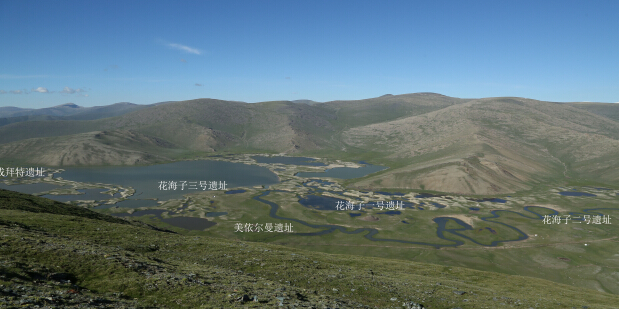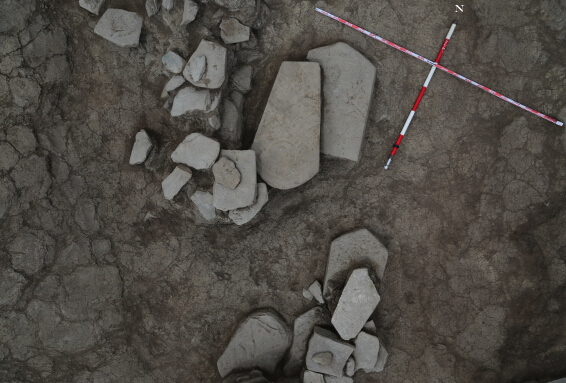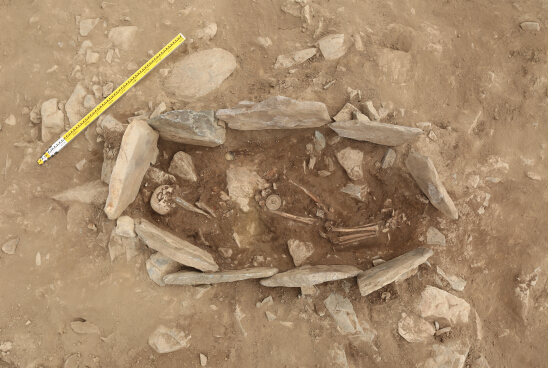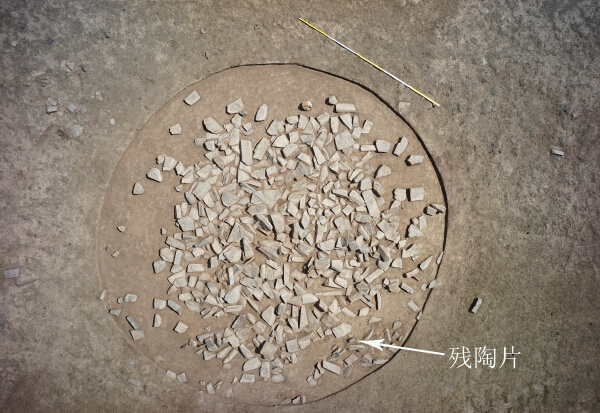Information
New discovery of Sandaohaizi Site group, Qinghe County, Xinjiang
Summary: Huahaizi No.1 Site is the biggest and the nearby Meiyierman area consists of ten sites, located surrounding the major springs in Huahaizi. The archaeological team excavated four Sites, finding that these stone piles are mainly sacrificial remains surround
Sandaohaizi Site group are located in Chaganguole Town Qinghe County Aletai Region, Xinjiang, the resource of Minor Qinggeli River. In 2001, Sandaohaizi Site and the Deer Stones were enlisted as one of the fifth key heritage preservation units.
The altitude of Sandaohaizi is 2700 meters. It is named by the three different sizes lakes in three different valleys. According to present survey, Sanhaizi area is spotted with 3 giant, 4 medium-sized and around 100 small stone piles, as well as 60 deer stones and several rock paintings, most of which are spotted in Huahaizi.

Map which Illustrated the Distribution of Main sites in Huahaizi
Sandaohaizi Site group is remarkable in single scale, structure and its number. There have been many speculations about its date and nature. In this way, a joint archaeological research team formed by the Institute of Archaeology, Chinese Academy of Social Science (IA CASS), Altay Municipal Administration of Cultural Heritage and Qinghe County Administration of Cultural Heritage carried out continuous excavation in Sanhaizi Site group in the four summers from 2013 to 2016. The work in 2016 is divided into two phases, one is the excavation of Tuoyelesayi Site in Huahazi area, covering an area of 800 square meters; besides, 8 tombs were also excavated in two locations in the valley of Chaganguole River.
Site is mainly made up of deer stones and stone circular sacrificial remain. We’ve unveiled the significance of this kind of sites. 21 stone circular sacrificial remains were unearthed. Most importantly, 3 buried deer stones and some well-preserved stone circular sacrificial remains were found.
We can speculate that Huahaizi No.3 Site is a cross-spoke stone remain, with two deer stones located in the edge of central stone pile. The most important discoveries are the engraved or plain stone shields at the end of the southeast spoke. The southwest spoke is formed mainly by stone shields. Several stone shields were also found in the central pile. Beneath the central stone pile is a southeast-northwest frame made of the trunks and branches of Siberian spruce. There was a pile of sacrificed human bone fragments in the frame, mainly from a male skull around forty years old. The genetic tests proved that he is an East Asian, Haplotype D. Two sheep teeth were also found here. There are two wooden stakes, one big and one small, beneath the human bones.

Shield-shaped Stone found in the Southeast Spoke
Huahaizi No.1 Site is the biggest and the nearby Meiyierman area consists of ten sites, located surrounding the major springs in Huahaizi. The archaeological team excavated four Sites, finding that these stone piles are mainly sacrificial remains surrounding the spring mouths.
Chengbaite area consist several stone piles, including two medium size circular piles and two small square piles and the rest are round piles. Six round stone piles were excavated in 2015, and two small sacrificial stone circles were cleared up. We know through the excavations that all these are sacrificial remains. In the high place tow sites found few horse teeth, sheep teeth as well as sheep bones and three sites were only stone structure left lack of bones or wares. The sacrificial circles have the same structure with that in Huahaizi No.3 Site, both with burnt ashes inside the stone circle.

A Khirigsuur Dating Back to Yuan Dynasty in Huahaizi No.3 Site
A khirigsuur dating back to Yuan Dynasty was found accidentally in Huahaizi No.3 Site. The owner of the grave is a young lady. A mirror with dragon and tiger pattern modeling Eastern Han style, patterned blue glass beads, black beads decorated with colorful sun patterns, glass beads, meat-red chalcedony beads, silver bowl and iron ware etc. were found in the grave. Part of the clothes of the tomb owner is kept till now. These fabrics were dated to be Yuan Dynasty. The finding offers substantial evidence to the Silk Road in the steppe.
At the beginning of the first millenium BC, Eurasian Steppe entered early Iron Age, when nomadic economy began, the society gained complexity and early nomadic states came into being. The main symbols are the artistic themes and objects embodying the whole ideology of ruling class and monarchs, grand royal cemetery and grand seasonal ritual center. Sandaohaizi and the widespread cross spoke stone circlesand piles together with deer stones are closely related with the motion of the sun, stars, the Milky way and other astronomical phenomenon, which was an importance segment of ideology of nomadic kingdom.

Ritual Pit No.21 found in Huahaizi No.3 Site
Tyva Arzhan Cemetery in Russia and the sacrificial remain in Sandaohaizi site share the same cultural elements and belong to the same period. The Addie Bayer/Sandaohaizi Cultural represented by Arzhan Cemetery and Sandaohaizi sites may be the remains of recorded Arimaspi and Yimu State written in Chinese documents. Both names mean a tribe of legendary one eyed people. They may be one of the earliest groups setting up nomadic state in Eurasian Steppes. Based on the scale and advanced ware analysis, we speculated that the Arzhan Cemetery was the royal tomb of early nomadic state and Sandaohaizi was their ritual center in summer. The periodic activities held in Sandaohaizi, the valley of Altai Mountain, the chiefs and core group of early nomadic states controlled the communication with the heaven and the gods, promoting their worship and culture, monopolizing the resources like gold and precious stones and their distribution.
Sandaohaizi Sites bear great importance to the study of the roles of nomadic and grand ritual activities played in the process of social complication. They are essential materials for the understanding of the organizing ability, ruling ideology, universe concept and the spiritual world of early nomadic states.

Deer Stone Found in Tuoyelesayi Site
In a word, Sandaohaizi site group possess unique historical and cultural value in the whole Eurasian Steppes. The ancient nomadic states that construct and made use of these sites were the core of nomadic groups connecting South Siberian in Russia, middle and west part of Mongolia, east of Kazakhstan and the mountain meadow in North China as well as their culture. They were the proactive explorers of the Silk Road on the prairies in early period, their cultural influence expanded through Europe and Asia, greatly influencing the latter generations. The later Scythian, Saka, Yuezhi and Hun inherited and promoted their culture. (Translator: Yuan Yuan)
The altitude of Sandaohaizi is 2700 meters. It is named by the three different sizes lakes in three different valleys. According to present survey, Sanhaizi area is spotted with 3 giant, 4 medium-sized and around 100 small stone piles, as well as 60 deer stones and several rock paintings, most of which are spotted in Huahaizi.

Map which Illustrated the Distribution of Main sites in Huahaizi
Sandaohaizi Site group is remarkable in single scale, structure and its number. There have been many speculations about its date and nature. In this way, a joint archaeological research team formed by the Institute of Archaeology, Chinese Academy of Social Science (IA CASS), Altay Municipal Administration of Cultural Heritage and Qinghe County Administration of Cultural Heritage carried out continuous excavation in Sanhaizi Site group in the four summers from 2013 to 2016. The work in 2016 is divided into two phases, one is the excavation of Tuoyelesayi Site in Huahazi area, covering an area of 800 square meters; besides, 8 tombs were also excavated in two locations in the valley of Chaganguole River.
Site is mainly made up of deer stones and stone circular sacrificial remain. We’ve unveiled the significance of this kind of sites. 21 stone circular sacrificial remains were unearthed. Most importantly, 3 buried deer stones and some well-preserved stone circular sacrificial remains were found.
We can speculate that Huahaizi No.3 Site is a cross-spoke stone remain, with two deer stones located in the edge of central stone pile. The most important discoveries are the engraved or plain stone shields at the end of the southeast spoke. The southwest spoke is formed mainly by stone shields. Several stone shields were also found in the central pile. Beneath the central stone pile is a southeast-northwest frame made of the trunks and branches of Siberian spruce. There was a pile of sacrificed human bone fragments in the frame, mainly from a male skull around forty years old. The genetic tests proved that he is an East Asian, Haplotype D. Two sheep teeth were also found here. There are two wooden stakes, one big and one small, beneath the human bones.

Shield-shaped Stone found in the Southeast Spoke
Huahaizi No.1 Site is the biggest and the nearby Meiyierman area consists of ten sites, located surrounding the major springs in Huahaizi. The archaeological team excavated four Sites, finding that these stone piles are mainly sacrificial remains surrounding the spring mouths.
Chengbaite area consist several stone piles, including two medium size circular piles and two small square piles and the rest are round piles. Six round stone piles were excavated in 2015, and two small sacrificial stone circles were cleared up. We know through the excavations that all these are sacrificial remains. In the high place tow sites found few horse teeth, sheep teeth as well as sheep bones and three sites were only stone structure left lack of bones or wares. The sacrificial circles have the same structure with that in Huahaizi No.3 Site, both with burnt ashes inside the stone circle.

A Khirigsuur Dating Back to Yuan Dynasty in Huahaizi No.3 Site
At the beginning of the first millenium BC, Eurasian Steppe entered early Iron Age, when nomadic economy began, the society gained complexity and early nomadic states came into being. The main symbols are the artistic themes and objects embodying the whole ideology of ruling class and monarchs, grand royal cemetery and grand seasonal ritual center. Sandaohaizi and the widespread cross spoke stone circlesand piles together with deer stones are closely related with the motion of the sun, stars, the Milky way and other astronomical phenomenon, which was an importance segment of ideology of nomadic kingdom.

Ritual Pit No.21 found in Huahaizi No.3 Site
Tyva Arzhan Cemetery in Russia and the sacrificial remain in Sandaohaizi site share the same cultural elements and belong to the same period. The Addie Bayer/Sandaohaizi Cultural represented by Arzhan Cemetery and Sandaohaizi sites may be the remains of recorded Arimaspi and Yimu State written in Chinese documents. Both names mean a tribe of legendary one eyed people. They may be one of the earliest groups setting up nomadic state in Eurasian Steppes. Based on the scale and advanced ware analysis, we speculated that the Arzhan Cemetery was the royal tomb of early nomadic state and Sandaohaizi was their ritual center in summer. The periodic activities held in Sandaohaizi, the valley of Altai Mountain, the chiefs and core group of early nomadic states controlled the communication with the heaven and the gods, promoting their worship and culture, monopolizing the resources like gold and precious stones and their distribution.
Sandaohaizi Sites bear great importance to the study of the roles of nomadic and grand ritual activities played in the process of social complication. They are essential materials for the understanding of the organizing ability, ruling ideology, universe concept and the spiritual world of early nomadic states.

Deer Stone Found in Tuoyelesayi Site
In a word, Sandaohaizi site group possess unique historical and cultural value in the whole Eurasian Steppes. The ancient nomadic states that construct and made use of these sites were the core of nomadic groups connecting South Siberian in Russia, middle and west part of Mongolia, east of Kazakhstan and the mountain meadow in North China as well as their culture. They were the proactive explorers of the Silk Road on the prairies in early period, their cultural influence expanded through Europe and Asia, greatly influencing the latter generations. The later Scythian, Saka, Yuezhi and Hun inherited and promoted their culture. (Translator: Yuan Yuan)
Category: English
News
Information
Key words:
